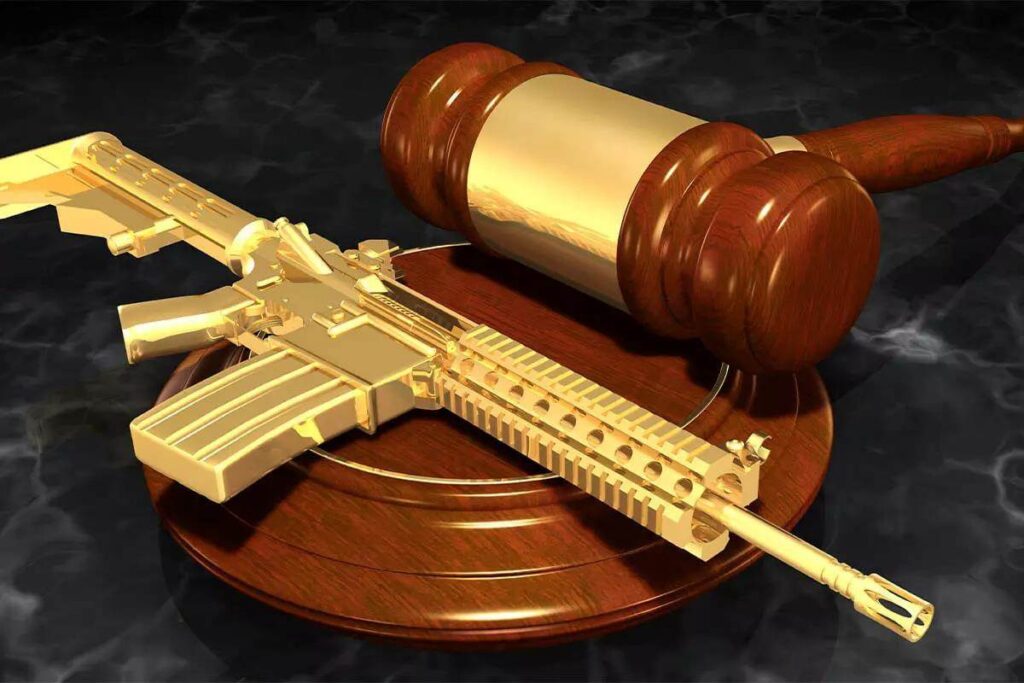Where’s My EMP Rifle? Why Tomorrow’s Anti-Robot Weapons Are Already Protected by the 2nd Amendment [More]

[More]
Notes from the Resistance
In response to a question of whether the people decide subjectively what they deem appropriate for self-defense, New Jersey argued that “the people” through their representatives decide what is unusually dangerous based on their perception of “objective characteristics.” As one judge suggested, since all firearms are dangerous under the alleged dangerous-or-unusual test, no limit would exist on what the legislature may choose to ban, despite what the people choose. [More]
Look at all the contortions these robed Democrats go through to obfuscate the unambiguous clarity of “shall not be infringed.”
How many horses and hounds may I keep, again…?
[Via Michael G]
Fact is, most firearms innovations have come from outside the government. [More]
Which is why “in common use at the time” can go from being a winning strategy in some circumstances to a trap more fundamental ones.
Face it: Every new idea starts as a monopoly.
Why our “gun rights leaders” seem deliberately indifferent to that is something you’ll have to ask them.
Their legal arguments are heavy on self defense and light on the militia, too.
[Via Michael G]
Second Amendment Roundup: Bruen Was Right [More]
Now what can SCOTUS do about the “inferior courts” thumbing their noses at it, and what can DOJ do about states?
That said, why all the emphasis on “common use“?
Imagine if Founding Era understanding were applied to other areas of law.
[Via Michael G]
Herschel springboards off my latest “common use” article and gives his own insights. [More]
I’m also interested in the guy in comments who felt the need to qualify his admission that I’m “absolutley correct here” by saying he “often disagrees with” me. Really? How? On what? Is it just from what he infers or can he prove something I said is wrong?

Since no innovation ever begins “in common use,” a government with the power to do so can ban all new weapon developments from those they would rule, retaining them exclusively for itself. [More]
Sorry, you can’t have one. Hey, it’s your “gun rights leaders” who embraced the “in common use” litmus test we’re using to deny you.
Accordingly, we hold that LCMs do not fit the constitutional definition of “arms” before even reaching whether they are “commonly used for self-defense.”However, LCMs also fall outside either protection of the right to bear arms because the provisions protect only those arms that are commonly used for selfdefense, and we have been presented with no credible and persuasive evidence or argument that LCMs are commonly used for such a purpose. [More]
Gee, who would ever think those arguments could be a trap?

In this conversation, Mark Walters and David Codrea delve into the complexities surrounding the Second Amendment and gun control. They discuss the implications of the ‘common use’ argument, the distinction between self-defense and militia purposes, and the political landscape regarding gun rights. Personal anecdotes highlight how perspectives on gun ownership can change over time, emphasizing the importance of understanding the historical context of the Second Amendment. [More]
The discussion revolved around my latest from Firearms News.
So, although I agree unequivocally with you that this is going to be and is being twisted to hurt us, so is every aspect of everything (SCOTUS Bruen footnote on permitting schemes, anyone?, and endless other dicta). I don’t see the point of eliminating this very good test because they will twist it like everything else they twist. My main reason for writing this is to hopefully get a reply back on your thoughts on what I am saying. [More]
See, I never said eliminate the test. I even agreed with showing how it can be a very effective tactic to use for now.
What I’m saying is don’t get so wrapped up in the “common use” argument that it restricts the introduction of other truths, and there are better arguments for challenging the restrictions on the full autos we’re entitled to that our legal “leaders” have not been inclined to use.
That and future devel0pments in weapons technology can be withheld from us because they’re not in common use.
Change the concept to “in common use by police and soldiers” and I’ll stop screaming at passing cars about it.
We’re awaiting word on Snope/Ocean State tactical, and if SCOTUS is going to make a decisoin or once more kick the can down the road. Meanwhile, here are some sobering thoughts:
This is especially frustrating to watch after feeling like I’m the lone voice in the wilderness warning that relying solely on “self defense” while ignoring the militia aspect makes 2A more vulnerable to infringements, and how putting all faith in the “in common use at the time” argument can be a trap.
[Via Jess]
N.Y. Federal Judge Upholds N.Y. Stun Gun/Taser Ban… “[T]he Second Amendment does not protect those weapons not typically possessed by law-abiding citizens for lawful purposes.” Therefore, Plaintiffs must show that stun guns and tasers are in “common use” today, and that they are “typically possessed by law-abiding citizens for lawful purposes.” [More]
[Via Jess]
A Russian strategist has argued that infantry weapons such as mortars and machine guns are obsolete. He said he believed drones would replace them, making infantry units smaller and lighter. [More]
So, where does that leave the Militia, especially if “in common use at the time” is what our “leaders” are hanging their hats on?
[Via bondmen]

It’s taking care of our immediate needs. However, the Founders bequeathed us a constitution intended “to secure the Blessings of Liberty to ourselves and our Posterity.” If this is all we concern ourselves with, what are we bequeathing to them? Semiautomatic firearm technology that’s already 140 years old…? In a world where technological developments and breakthroughs are being introduced seemingly exponentially, what new “terrible implements” will become standard issue in the next 140 years? [More]
In avoiding legal traps today, care must be taken not to catch ourselves in a more dangerous one tomorrow.
This is How They’ll Just Ignore the Second Amendment [Watch]
I seem to recall somebody — an obscure bellyacher, not a recognized Second Amendment scholar — warning not to overly rely on the “common use” test…
[Via Jess]
ANTI-GUN WASHINGTON POST MAKES HUGE PRO-2A ADMISSION [Watch]
Perhaps. But tying “in common use at the time” to commercial popularity can be a trap.
[Via Jess]
M-16 Era Ends: Army’s 101st Airborne Division Receives Next-Gen Assault Rifles [More]
You and I can’t have those either, because they’re not “in common use.”
As long as we allow that to be defined by what’s popular for “self-defense” and sport as opposed to arms that soldiers bear, we’re giving the prohibitionists an out to screw us.
[Via bondmen]
As should be obvious to all regulars, I do freedom and culture and leave the hardware to those who know it better than I do, which is no doubt many of you. That said, this was just called to my attention and I’m calling ot to yours:
Is this something thast new materials and tech would allow to be perfected?
And if somebody tried, would “in common use” prove a hindrance?
[Via WiscoDave]
What Part of ‘In Common Use’ Don’t You Understand?: How Courts Have Defied Heller in Arms-ban Cases — Again [More]
What I still don’t understand: What if it’s not “in common use” by the public, but is by the military/LE, like post-’86 select-fire rifles?
I know what I say the answer is. I’d like to see it clearly stated by someone with legal gravitas and then challenged in court.
[Via Jess]